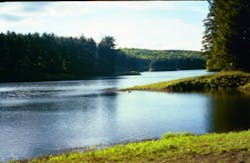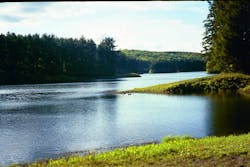Open-channel flow occurs when liquid flows in a conduit or channel with a free surface. Rivers, streams, canals, and irrigation ditches provide examples of open channel flow. What is slightly confusing about this terminology is that the flow of liquids in partially filled pipes, when not under pressure, is also considered open-channel flow. For example, water flowing through a culvert running underneath a street is considered open-channel flow. Likewise, flows in sewers and tunnels are classified as open-channel flows, along with other closed channels that flow partly filled. Other examples of open-channel flow include flow in water treatment plants, storm and sanitary sewer systems, industrial waste applications, sewage treatment plants, and irrigation systems.
A very common method of open-channel flow involves the use of a hydraulic structure such as a weir or flume. These hydraulic structures are called primary devices. A primary device is a restriction placed in an open channel that has a known depth-to-flow relationship. Once a weir or flume is installed, a measurement of the depth of the water is used to calculate flowrate. Charts are available that correlate various water depths with flowrates, taking into account different types and sizes of weirs and flumes.
A weir resembles a dam placed across an open channel. It is positioned in such a way that the liquid can flow over it. Weirs are classified according to the shapes of their openings. Types of weirs include:
- V-Notch
- Rectangular
- Trapezoidal
Water depth is measured at a specific place upstream from the weir. An equation for determining flowrate is associated with each type of weir.
A flume is a specially shaped portion of the open channel with an area or slope that is different from the channel’s slope or area. The velocity of the liquid increases and its level rises as it passes through the flume. To determine flowrate, liquid depth is measured at specified points in the flume. An equation is associated with each kind of flume, taking flume size into account.
Flow can be measured without a hydraulic structure such as a weir or flume. In the area velocity method, the mean velocity of the flow is calculated at a cross-section, and this value is multiplied by the flow area. Normally, this method requires that two measurements be made—one to determine mean velocity and another measurement to determine depth of flow. The area velocity method is used when it is not practical to use a weir or flume, and for temporary flow measurements. Examples include influx and infiltration studies and sewer flow monitoring.
An increasing need to measure water flow due to population growth and environmental regulations are important driving forces behind the open channel flowmeter market. While energy needs get many of the headlines, the need to supply clean water to many populations, and also to provide wastewater services, is becoming more important. Besides increased population, unusual weather patterns that create droughts and dry water beds are becoming more common. This is true in the United States and also in other regions of the world. Just as oil and gas must be measured when it changes ownership, so too does water need to be measured when ownership is transferred from one person or entity to another. Custody transfer of water is a critical measurement, just as is custody transfer of oil and gas.
While pressurized closed-pipe flow has grabbed much of the attention, open-channel flow measurement is an exciting area that is worth a closer look. Although it can be difficult to grasp at first because of the variety of methods, this variety also provides room for new technologies. As is the case with closed-pipe flow, many of the recent developments revolve around electronic enhancements and improvements in communication. There is also room for truly novel developments involving new sensor technologies, or the improvement of existing sensor technologies. Some improvements of this type have already occurred with Doppler technology. Watch for further developments as companies vie for a growing market.
For more information on Flow Research’s work in the area of vortex flow measurement, visit FlowOpenChannel.com.



